Art by Betmatrho in
this Red-Thread Genealogy section for the
'Lost Tribes of Israel'
may
be freely used for personal use.
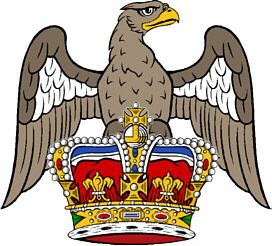 English
Origins:
English
Origins:Coat of Arms:
A red shield with a chevron vair between three gold lions rampant.
[Vair. One of the furs being party coloured ar. and az., and always so understood, if not named to the contrary.]
Crest:
Out of a ducal coronet a demi eagle wings expanded sable.
Motto: Loyal unto death.
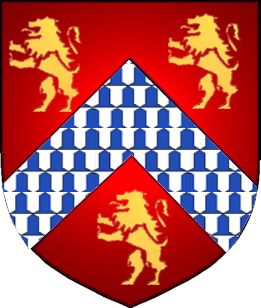
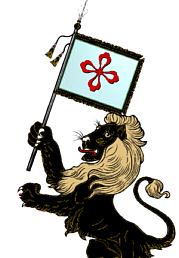 Coat of Arms: Silver, with a
chevron engrailed between three red roses.
Coat of Arms: Silver, with a
chevron engrailed between three red roses.Crest: A black demi lion rampant holding a silver flag with a red cross.
Motto: Echel agus coruic.
Motto Translated: The axle and coryg.
Spelling variations include: Whyte, Wight, Whight, White, MacWhite, MacFaoitigh and many more.
First found in Ireland after the Anglo-Norman invasion of the 12th century, when Walter Whyte is known to have come to Ireland with 'Strongbow'.
Some of the first settlers of this name or some of its variants were: William White and his wife Susannah, who immigrated to Plymouth in 1620 with their sons Resolve and Peregrine (who was born in Cape Cod Harbour on board the Mayflower in 1620.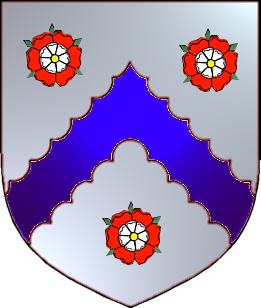
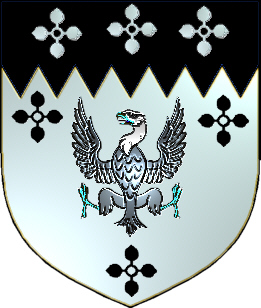 Coat of Arms:
Coat of Arms:Argent, an eagle displayed between three quatrefoils sable, and on a chief indented of the second as many quatrefoils of the first.
[Argent. Silver. Usually painted white, one of the two metals; when the shield is argent, it is shown in an engraving by being left plain. See Tinctures.]
[Sable. Black; in engraving is represented by perpendicular and horizontal lines crossing each other.]
[Quaterfoil or Quatrefoil. Four leaved grass. The Quaterfoil was an imitation of the primrose, which being one of the first Flowers of the Spring, was considered as the harbinger of revivified nature, and was adopted by the church architects to signify, emblematically, that the gospel, the harbinger of peace and immortality, was there preached. The Trefoil was the emblem of the Trinity.]
Crest: Description not available
Motto: Labore parta.
Motto Translated: Acquired by work.
WHITE
(British). "White, of hair or complexion."
Clan: White, Whyte Sept: Lamont, MacGregor
Clan: White, Whyte Sept: Lamont, MacGregor
Spelling variations include: White, Whyte, Wight and others.
First found in Durham, where the white family held a seat from very early times.
Some
of the first settlers of this name or some of its variants were:
William White and his wife Susannah, who immigrated to Plymouth in 1620
with their sons Resolve and Peregrine (who was born in Cape Cod Harbour
on board the Mayflower in 1620.
Note: For the German 'White' surname, see Weise.
![The Red Thread Coat of Arms sample coat of arms [full]](http://the-red-thread.net/genealogy/bailey-stationary.jpeg)
Sample Coat of Arms - Full
http://genforum.genealogy.com/white
LOST TRIBES OF ISRAEL IDENTITY
Spelling variations include: White, Whyte, Wight and others.
First found in Durham where they held a family seat from very early times.
Some of the first settlers of this name or some of its variants were: Peter White settled in Witless Bay, Newfoundland, in 1676; Arthur White settled in Ferryland in 1706. Many settled in Newfoundland, in such places as Harbour Grace, Bacon Cove, Bonavista, Petty Harbour, Greenspond, Ship Island, Salmon Cove, and Heart's Content. William White, his wife Susannah, and sons Peregrine and Resolve, settled in Plymouth in 1620 (Peregrine White was born in Cape Cod Harbour on board the Mayflower in 1620, thus becoming the first child of English descent born in New England). William White settled in Virginia in 1635.
First found in Durham where they held a family seat from very early times.
Some of the first settlers of this name or some of its variants were: Peter White settled in Witless Bay, Newfoundland, in 1676; Arthur White settled in Ferryland in 1706. Many settled in Newfoundland, in such places as Harbour Grace, Bacon Cove, Bonavista, Petty Harbour, Greenspond, Ship Island, Salmon Cove, and Heart's Content. William White, his wife Susannah, and sons Peregrine and Resolve, settled in Plymouth in 1620 (Peregrine White was born in Cape Cod Harbour on board the Mayflower in 1620, thus becoming the first child of English descent born in New England). William White settled in Virginia in 1635.
